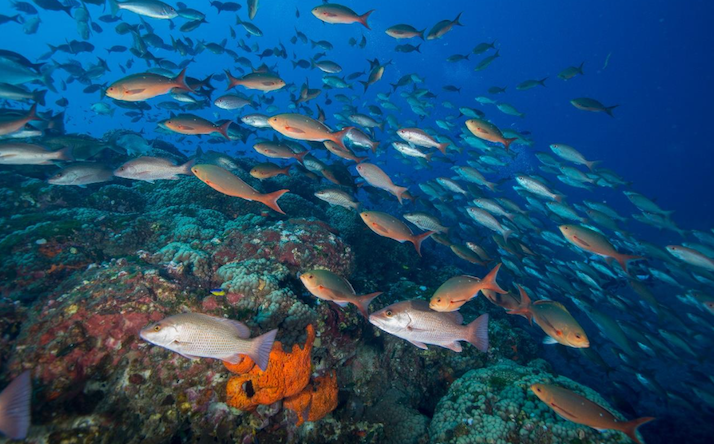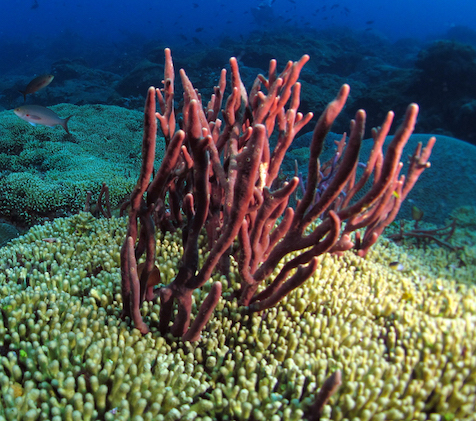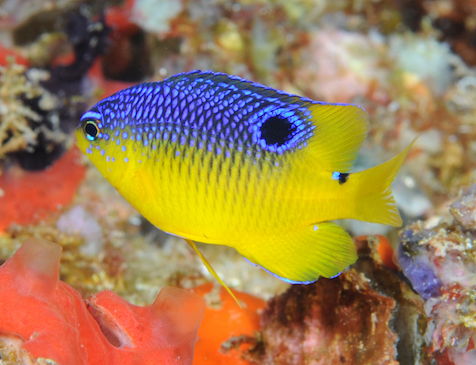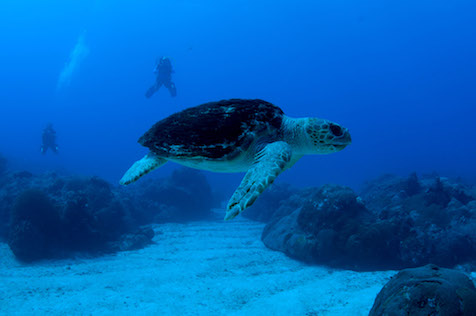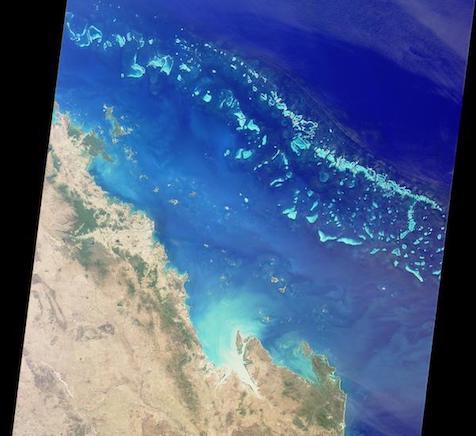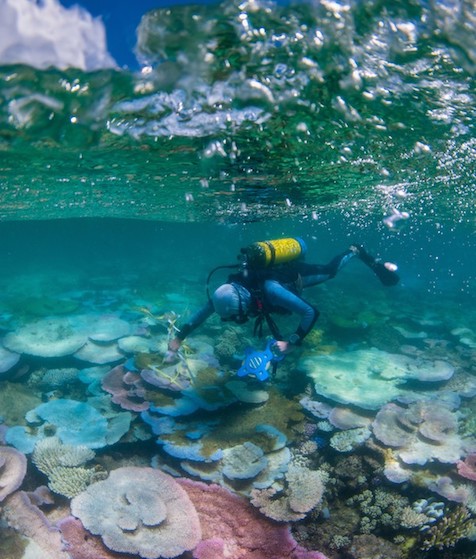Melissa Gaskill, an accomplished science journalist as well as scuba diver, has made underwater visits to the Gulf of Mexico’s Flower Garden Banks and Australia’s Great Barrier Reef. In this special two-part report for Texas Climate News, she examines the impacts of a warming climate on coral reefs and marine ecosystems that they’re a crucial part of.
+++
By Melissa Gaskill
Texas Climate News
Scuba divers call the Flower Garden Banks National Marine Sanctuary “the Texas Caribbean” because, underwater, it so closely resembles the actual Caribbean.
The Sanctuary’s three separate areas — the East, West and Stetson Banks — protect roughly 56 square miles of coral reefs 100 miles from the Texas coast. These reefs grow atop geological formations called salt domes rising from the Gulf of Mexico floor, creating an environment that supports more than 20 species of coral, hundreds of species of invertebrates and fish, including some 20 different sharks and rays, and more. Thanks to a remote location and protected status, the reefs have long remained healthier than most in the Caribbean.
But the effects of climate change reach even here.

Flower Garden Banks National Marine Sanctuary (FGBNMS) is located near the Texas and Louisiana coasts.
For 85 days during the months leading up to October 2016, sea-surface temperatures at the Sanctuary topped 86 degrees F (30 degrees C). On Oct. 5, Sanctuary scientists reported that almost half of coral colonies in a study site had bleached or were in the process of bleaching. At that point, up to 46 percent of corals within long-term monitoring stations exhibited signs of bleaching, with total bleaching of 24 percent at the East Bank and 10 percent at the West.
“Bleaching” refers to a response by corals to stress. Reef-building corals consist of thousands of soft-bodied individual animals, called polyps, with hard external calcium carbonate skeletons. Photosynthetic algae, or zooxanthellae, live in the tissues of each polyp, providing 80 percent of its nutritional requirements. Most reef-building coral species grow best in water between 73 and 84 degrees F (23 and 29 degrees C).
When temperatures rise above that range, corals become stressed and expel their algae. Because these algae also give corals their vibrant colors, without them the coral skeleton appears white, or bleached. “Paling” refers to corals in the process of bleaching.
Unless water temperatures drop to normal ranges and a coral takes algae back in, it will eventually starve and die.
Fortunately, this bleaching event, while one of the worst ever recorded here, did not result in significant coral mortality. Water temperatures dropped in the fall and Sanctuary research coordinator Emma Hickerson says staff scientists documented almost full coral recovery by November.
A global event
But this latest bleaching at the Flower Garden Banks is part of a global coral bleaching event, meaning one affecting all three tropical basins, in the Atlantic, Pacific and Indian Oceans. The first documented global event occurred from 1997 to 1998, with at least 15 percent of reefs dying worldwide. A second event happened in 2010; that one also affected the Flower Gardens.
This most recent event began in mid-2014 and the National Oceanic and Atmospheric Administration’s Coral Reef Watch has called it the longest, most widespread, and most damaging on record, affecting more reefs than any before. Mass bleaching even occurred in several never-before-bleached reefs, including the northernmost Great Barrier Reef of Australia, and more than 70 percent of the world’s coral reefs have experienced heat stress sufficient to cause bleaching or mortality.
Last month, NOAA announced that widespread coral bleaching was no longer occurring in all three ocean basins, signaling an end to the global event but not entirely to bleaching. NOAA’s four-month coral bleaching outlook shows continued risk to coral reefs in Hawaii, Florida and the Caribbean later this summer.
It all boils down to record-breaking water temperatures, a result of climate change. A study published in Nature’s Scientific Reports in December 2016 reported that 97 percent of the more than 60,000 coral reefs around the globe saw rising water temperatures from 1985 through 2012.
No wonder. April 2017 marked 388 consecutive months of globally-averaged temperatures above the 20th century average. The Global Climate Report for April 2017 from NOAA’s National Center for Environmental Information noted that the combined global average temperature that month was 1.62 degrees F (0.90 degree C) above the 20th century average — the second highest April temperature since global records began in 1880, behind only 2016.
The ocean absorbs and stores more than 90 percent of the heat trapped by greenhouse-gas emissions. “All ocean basins examined have experienced significant warming since 1998,” absorbing more heat than previously thought, states a March 2017 paper in Science Advances. Due in part to circulation patterns, this heat distributes unevenly in the world’s oceans, with nearly 60 percent of it in the Atlantic and Southern Oceans.
Scientists around the globe link increased temperatures causing the bleaching to climate change. “We have seen an increase in temperatures at the Flower Gardens, and the resulting bleaching event is due to climate change,” says Hickerson.
A study in the international journal PeerJ shows temperature as by far the most influential factor in coral bleaching at Hanauma Bay Nature Preserve on Oahu, Hawaii. The authors write, “Drastic increases in global carbon emissions in the past century have led to elevated sea surface temperatures that negatively affect coral reef organisms” across the globe.
“Immediate action” needed
Authors of a March 2017 paper in Nature, “Global warming and recurrent mass bleaching of corals,” concluded “immediate global action to curb future warming is essential to secure a future for coral reefs.”
Mark Eakin, coordinator of NOAA Coral Reef Watch, calls halting climate change and reversing the damage it has already done “critical,” noting that doing so requires reducing carbon dioxide from human activities in the atmosphere.
How critical? Scientists at the University of Miami Rosenstiel School of Marine and Atmospheric Science predict that if greenhouse-gas emissions do not decrease and current trends continue, “severe bleaching will occur every year on 99 percent of the world’s reefs within the century.” Even if emission reductions exceed those pledged by nearly 200 nations in the Paris Climate Agreement, more than three-quarters of the world’s reefs will bleach every year by 2070, the researchers projected.
Because recovery from a bleaching event takes at least five years, annual bleaching will mean major changes in the ecology and function of coral reef ecosystems. Scientists warn we could see a complete collapse of these ecosystems within 30 years and disappearance of 90 percent of reefs by 2050.
The Flower Garden Banks may fare better than most, at least for a while. “We are insulated by offshore conditions, a deep water environment, and more resilient corals,” says Hickerson. “But once we get into increased, more regular bleaching, that decreases the ability of the corals to respond to an event.”
Other sources of stress decrease the overall resilience of reefs and, in turn, their ability to respond to bleaching. In July, prior to the 2016 bleaching event in the Sanctuary, a severe and unexpected die-off of coral and other invertebrates affected 6.5 acres of the East Bank.
This die-off wasn’t bleaching, but may also stem from climate change. Unusual and unseasonal amounts of rainfall, a pattern attributed to climate change, dumped significant amounts of freshwater into the Gulf.
Oceanographic conditions may have drawn that freshwater into the Sanctuary, exposing marine life to lower than normal salinity levels, and the water may have contained nutrients leading to an algal bloom. Scientists from Texas A&M University, Rice University, University of North Carolina, Baylor University, University of Texas at Dallas, and the University of South Florida continue working to determine the cause or combination of causes behind the die-off.
“There may be a whole host of different events that contributed to it,” says Hickerson. Likewise, the grim picture at coral reefs around the world results not from a single cause but from insult piled upon insult, year after year. It all adds up.
To enhance the Sanctuary’s overall resilience and to protect additional reefs and bottom features, NOAA proposed increasing its protected area by almost 700 percent, placing an additional 15 banks covering about 383 square miles within its boundaries. The agency worked with various constituencies to develop its recommendation for expansion, backed by an extensive body of research, including the Sanctuary’s own annual coral reef monitoring program, one of the longest-running such programs in the world.
Extra protection halted
However, that expansion is now on hold. An executive order signed by President Trump on April 28 declares “it shall be the policy of the United States to encourage energy exploration and production, including on the Outer Continental Shelf” and calls on the secretary of Commerce, who oversees NOAA, to refrain from designating or expanding any national marine sanctuary without a full accounting of the designated area’s energy potential. The language appears to specifically target the Flower Garden Banks, the only sanctuary in a drilling zone considering expansion.
Bottom line: Whatever the cause, the world faces significant loss of coral reefs and the resulting consequences could be catastrophic. Reefs house at least a quarter of all marine life worldwide, supporting commercial and recreational fishing and tourism industries, and provide physical protection of coastlines from storms, waves and erosion. The estimated global, annual value of these services tops $2 trillion, including $36 billion per year for tourism alone.
The economic impact of recreational diving alone at the Flower Gardens, through a single operator, totals roughly $2.7 million.
The actual value of these reefs is harder to calculate, says David Yoskowitz, chair for socioeconomics at the Harte Research Institute for Gulf of Mexico Studies at Texas A&M University-Corpus Christi. “Placing a value on natural assets becomes very difficult. Many of these things are not replaceable. We can value activities associated with the reef, but can’t get to its true value to humankind.”
NOAA’s Fisheries Service reports the economic effect of saltwater recreational fishing in Texas was $1.9 billion in sales, $1.2 billion in contributions to the regional gross domestic product (known as value-added), and 15,400 jobs in 2015. That year, the commercial seafood industry in Texas accounted for $173,419 in revenue, $492,440 in value-added, and 14,571 jobs, not counting imports. Recreational and commercial fisheries depend on a healthy Gulf ecosystem, Yoskowitz says, and the reefs in and around the Sanctuary play a role in that health.
NOAA’s Outlook of Coral Bleaching Heat Stress for June to September 2017 puts the chance of an Alert Level 1 (bleaching likely) at 60 percent for the Flower Garden Banks. Water temperatures already had climbed above 20-year averages in May, Hickerson says.
“We are watching to see what water temperatures look like this year and, if we need to respond and go back out and measure, we are ready to do that,” she adds. “One great thing about these long-term monitoring sites, we know these corals and where they should be. We have long-term records and can see when things change. Indications are that we may be going into a second bleaching year, but time will tell.”
+++
Great Barrier Reef – coral bleaching’s poster child
By Melissa Gaskill
Texas Climate News
The largest living marine structure on Earth, the Great Barrier Reef (or GBR) off the east coast of Australia, contains as many as 3,000 individual reefs stretching 1,430 miles. Scientists report that along some 435 miles of its northern end, two-thirds of the reef died as a result of bleaching in 2016, and this year, two-thirds of the middle section, about 150 miles between the cities of Cairns and Townsville, has died. Overall, nearly half of the GBR’s corals overall likely have died — the largest die-off here ever — with no relief in sight.
Bleaching in 2016 and 2017 represented the first back-to-back events on the GBR in successive years, according to Terry Hughes, director of the ARC Centre of Excellence for Coral Reef Studies at Australia’s James Cook University. In numerous reports and interviews, Hughes blames climate change, given abnormally high temperatures in waters surrounding the reef.
An increase of 1 degree C (1.8 degree F) so far has already caused four bleaching events in 19 years here, and these repeated bouts of bleaching now appear to be changing the basic makeup of the GBR. These reefs include a wide diversity of coral species, some more sensitive to bleaching than others. While some corals are surviving, according to NOAA Coral Watch program coordinator C. Mark Eakin, the overall effect is less diversity.
“Coral reefs in the Anthropocene,” published in the June issue of Nature, states, “In the coming centuries, reefs will run the gauntlet of climate change, and rising temperatures will transform them into new configurations, unlike anything observed previously by humans.” Co-author Jeremy Jackson, professor at the Smithsonian Tropical Research Institute, notes, “Reefs suffer simultaneously from dredging, over-harvesting, pollution, sewage, sediments, and steadily increasing temperatures.” The combination of these insults rapidly changes the mix of species on reefs.
That kind of species shift has yet to occur at the Flower Garden Banks National Marine Sanctuary in the Gulf of Mexico near Texas, says Emma Hickerson, research coordinator for that federally protected area. “One of the questions I have is how [bleaching effects] might play out in the greater Caribbean region. We have fewer species than in the Pacific, but the species are different.”
Blueprint for protection
Australia’s Reef 2050 Plan provides the framework for protecting and managing the Great Barrier Reef. The Australian and Queensland governments produced the plan in March 2015, in part to forestall placement of the GBR, a U.N.-designated World Heritage Site, on that program’s List of World Heritage in Danger. The list exists “to inform the international community of conditions which threaten the very characteristics for which a property was inscribed on the World Heritage List, and to encourage corrective action,” according to the World Heritage Committee.
In May, the Reef 2050 Plan’s Independent Expert Panel issued a communique stating that “action to reduce emissions of greenhouse gases must be central to the response” to recent bleaching events and calling for changes to the Plan to include climate change adaptation and mitigation actions.
Without such action, corals will continue to experience bleaching events, Hughes predicted in an ARC publication. Ultimately, he said, “we need to cut carbon emissions.” He also emphasized the importance of the international Paris Agreement aimed at limiting climate change, known in diplomatic parlance as COP 21:
“If COP21 fails badly, coral reefs as we know them today will be destroyed.”
+++++
Melissa Gaskill, a Texas Climate News contributing editor, is an Austin-based writer whose work has been published by Nature News, Scientific American, Wildflower, Texas Parks & Wildlife Magazine, Smithsonian, Men’s Journal and others. She received a bachelor’s degree in zoology from Texas A&M University and a master’s degree in journalism from the University of Texas at Austin.
Image credits: Flower Gardens photos and map – Flower Garden Banks National Marine Sanctuary. Satellite image of the Great Barrier Reef – NASA. Great Barrier Reef photo – ©Ed Roberts/Tethys Images via ARC Centre of Excellence for Coral Reef Studies.

